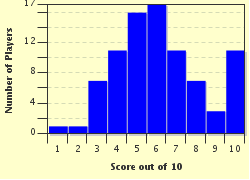Quiz Answer Key and Fun Facts
1. Which English nobleman is called 'the father of canals'?
2. Which period is often called 'The Golden Age of Canals'?
3. What does 'lock' mean in canal terminology?
4. English canals are classified as 'broad' or 'narrow'. What defines the difference?
5. What is the 'Grand Cross'?
6. What was the predominant type of power used on canals during the Golden Age?
7. The narrow canals gave birth to a particular type of boat. What was it called?
8. The majority of canal builders and engineers were English. Who was a notable exception?
9. In 1944 L.T.C. Rolt published a book describing his experiences while cruising with his wife on the canals. What was the title of the book?
10. What is a 'contour' canal?
Source: Author
Charlesw321
This quiz was reviewed by FunTrivia editor
bloomsby before going online.
Any errors found in FunTrivia content are routinely corrected through our feedback system.


